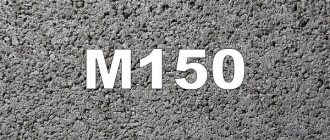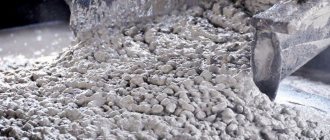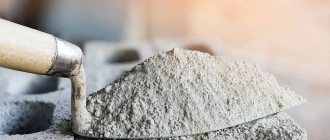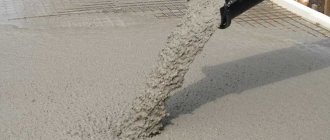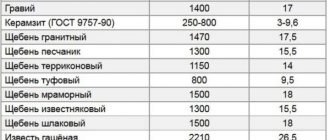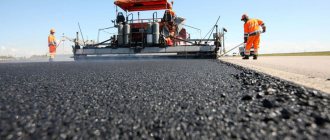Many materials in construction and other fields can be marked with certain values that reflect certain characteristics. Thanks to this, it is much easier to navigate the variety of choices, determining the most suitable type of material. The brand of asphalt also reflects certain characteristics of the mixture, but with its help it is not always possible to draw an unambiguous conclusion.
“The grade of asphalt does not indicate the level of strength of asphalt concrete mixtures, but a combination of various parameters and characteristics. In other words, the grade of asphalt is not able to unambiguously indicate the level of all characteristics of the material, but it can simplify the overall assessment of the properties of asphalt concrete mixtures.”
This is due to the fact that asphalt concrete is classified according to many characteristics, and some varieties of asphalt are intended only for a certain type of surface.
For example, the same brand of asphalt may include:
- 1. High-quality asphalt, which contains at least 50-60% crushed rock, as well as various modifiers to improve quality. This material is used for the construction of high-category roads with high traffic flow.
- 2. Sandy asphalt that does not contain stone aggregate. This type of asphalt concrete mixtures is not used for paving roads, since its characteristics are not designed to withstand heavy traffic flow. Sand mixtures are used to create areas for pedestrian movement where vehicle traffic does not occur.
It turns out that one brand includes both the most durable type of asphalt concrete and one of the least durable, not suitable for constructing roads. At the same time, the grade of asphalt still reflects the level of quality of the material, however, only when used under operating conditions suitable for this type.
Before ordering asphalting, we recommend that you familiarize yourself with the basic parameters of the classification of asphalt concrete, which will allow you to select the optimal type of material for certain purposes.
What does the asphalt grade reflect?
The asphalt grade can use several basic parameters for classifying asphalt concrete mixtures:
- Composition – reflects the possible type of base material;
- Density – determines the level of density/porosity;
- The principle of dilution of bitumen in the composition - reflects the required conditions during installation;
- Type – indicates the percentage content of rocks.
More details about the main parameters of asphalt concrete mixtures are written after the description of the brands.
| Brand | Description |
| I | This brand of asphalt may include various mixtures:
These mixtures can be crushed stone, gravel and sand - hot and cold - the composition may contain mineral powder. Depending on the combination of the main aggregate, grain size and density, grade 1 asphalt concrete can be used to construct asphalt pavements for various purposes, and can also be laid at different levels. Grade I asphalt implies high resistance to external factors if the asphalt concrete mixture is used for its intended purpose.
As a rule, the 1st grade of asphalt includes materials that have a higher cost compared to analogues of the 2nd and 3rd grades. |
| II | This brand of asphalt may include various mixtures:
These mixtures can also be crushed stone, gravel and sand - hot and cold - the composition may contain mineral powder. Despite the fact that the 2nd grade of asphalt implies the average quality of the asphalt mixtures included in it, it is the most widespread and in demand. The resistance of materials to mechanical and climatic influences will be lower than analogues of grade I, but the level will still remain high. This is due to the fact that maximum physical and mechanical characteristics are not required for all types of coatings. Grade II asphalt is widely used for the construction of ordinary city roads and sidewalks. It is grade 2 asphalt concrete mixtures that make up the majority of urban road surfaces: highways, sidewalks, squares, etc. Grade II asphalt is more affordable compared to analogues of Grade I. |
| III | This brand of asphalt includes mixtures that do not contain stone filler:
Despite the fact that such mixtures have a high density, their strength is significantly lower than that of crushed stone and gravel options. However, the lack of strength can be partially compensated by the addition of various additives. The sand mixture can be based on ordinary sand, as well as sand from rocks. The second option will have higher strength. |
Methods for determining asphalt density
Asphalt is a complex composite material, which includes mineral filler (crushed stone, gravel, sand, screenings, mineral powder) and bitumen. Each of these components has its own physical characteristics. In addition, the properties of asphalt concrete mix (ABC) change during the technological processes of production, transportation, placement and compaction. The material is compacted under the influence of gravity or external influences, gaining density and rigidity. This process needs to be controlled somehow.
Consequently, for asphalt concrete, not one, but several density indicators are determined - in different states and at different stages of production.
These include:
- Bulk density
- Maximum (true) density
- Maximum (true) density of the mineral part (framework)
- Bulk (average) density
- Volumetric (average) density of the mineral part (framework)
Let's talk about how these values are calculated.
Bulk density of asphalt
This indicator characterizes the density of the material when backfilled freely - that is, without additional compaction or compaction. It does not refer to the asphalt in the finished road surface, but to the loose asphalt concrete mixture before it is laid.
The property is measured very simply: a certain volume of material is poured into a container and weighed. Then the resulting mass is divided by the volume and the density value is obtained. It is expressed in kg/m3 or g/cm3.
The bulk density of asphalt and other bulk materials is not standardized by GOSTs. But it is of great importance when ordering. Based on this indicator, dump trucks for transportation with the required carrying capacity are selected and the delivery price is calculated.
Bulk density depends on:
- Grain masses of 1 m3 of asphalt on crushed stone made of dense and heavy rock will weigh more than the same volume of material on light aggregate (for example, expanded clay).
- Grain size Small particles fit tightly together when filling, while air voids form between large ones.
In the table you can see the approximate bulk density values for different types of asphalt:
| Type of asphalt | Bulk density |
| Cast asphalt | 1500 kg/m3 |
| Sandy asphalt | 1500 kg/m3 |
| Fine-grained asphalt | 1300 kg/m3 |
| Coarse asphalt | 1100 kg/m3 |
| Asphalt chips (asphalt cuttings) | 1700 kg/m3 |
For your convenience, below is the same table in the form of a picture:
Naturally, these figures are indicative only. Specific values will vary from formulation to formulation. They need to be obtained directly from the manufacturer or supplier.
Although bulk density is important at the stage of ordering and paying for a building material, it does not say much about its quality. This requires other indicators that are determined in laboratory conditions. We'll talk about them below.
Maximum (true) density of asphalt
This indicator characterizes the density of the material without taking into account pores. Imagine that 1 m3 of asphalt concrete mixture was compressed so that there were absolutely no air voids left in it. The ratio of the resulting mass to volume is its maximum density.
Naturally, it is impossible to achieve such compaction when laying a road. So this indicator is rather theoretical in nature.
Regulatory methods for determining maximum density are given in the following documents:
- GOST 12801-98 “Materials based on organic binders for road and airfield construction. Test Methods" (here the term "true density" is used)
- GOST R 58401.16-2019 “Asphalt concrete road mixtures and asphalt concrete. Methods for determining maximum density"
Below we will outline the second technique, since it was adopted later and is therefore more relevant. If you wish, you can review both documents yourself.
Determining density begins with preparing the material. To do this, at least two samples weighing approximately 1500-4000 g are taken from the asphalt concrete mixture. Then they are dried and crushed, manually separating large grains from small ones so that no lumps remain in the sample.
The further algorithm of actions depends on the specific measurement method:
- Weighing in water
- Air weighing
Let's look at them separately.
When weighing in water, do the following:
- ABS is poured into a vacuum bowl, weighed and the result obtained is recorded, subtracting from it the mass of the bowl itself. This is the mass of dry mixture A.
- The ABS in the bowl is filled with water so that its level is 25 mm above the level of the mixture. This is done to completely remove air from the material. To facilitate the process, you can also add 5-10 ml of a solution of surfactants - a wetting agent.
- A pump is connected to the bowl and all air is removed from it under a pressure of 27.5 mm Hg. and with constant vibration. In laboratories where there is no vibration equipment, the bowl with water and mixture is simply shaken periodically.
- After 15 minutes, the vacuum is released, and the bowl with its contents is immersed in water and weighed. The result is recorded - this is the mass of the bowl with the mixture in water B.
- Then the asphalt concrete mixture is taken out of the bowl, and the bowl itself is weighed in water. This value is recorded as the mass of the bowl C.
- The value of the maximum density Gmm is calculated for each tested sample using the formula:
- The arithmetic mean of all obtained values is taken as the final indicator.
This method is the main one. But laboratories can also use an alternative - air weighing.
The procedure is as follows:
- They start by filling the empty bowl with water to the brim and covering it with a lid. At the same time, make sure that there are no air bubbles left in the liquid. The container with water is weighed, and the resulting value is recorded as mass D.
- The water is poured out of the bowl and it is dried. Then the prepared ABS is poured into an empty container and weighed. Determine the mass of dry mixture A.
- Next, air is pumped out from the bowl with the mixture and water in the manner described in paragraphs 2-3 above.
- After 15 minutes, the vacuum is released, water is added to the bowl to the brim and the mass of the bowl with the mixture and water is measured in air E.
- For each sample, the maximum density Gmm is determined using the formula:
- The Gmm indicator for the mixture as a whole is taken as the arithmetic mean of all obtained values.
The maximum (true) density value is used to determine other important characteristics of asphalt concrete - for example, mineral density or compaction coefficient. We'll look at them in detail below.
Maximum (true) density of the mineral part (framework)
This characteristic is similar to that described above, only it concerns directly the mineral components of the mixture without taking into account bitumen: crushed stone (gravel) and sand (screenings).
The maximum core density is obtained by calculation.
To do this you need to know:
- The percentage of components in a specific ABS
- The true density of each mineral material
The latter indicator can be obtained from the manufacturer of the raw materials, measured in the laboratory, or calculated based on data on the porosity of the material, if available.
In the table below you can see the approximate values of the true and bulk density of materials used to produce asphalt:
| Material | Bulk density | True Density |
| Granite crushed stone | 1400-1600 kg/m3 | 2600-2800 kg/m3 |
| Natural sand | 1300-1600 kg/m3 | 2000-2800 kg/m3 |
| Dropout | 1300-1900 kg/m3 | 2000-4700 kg/m3 |
| Mineral powder | 900-1200 kg/m3 | 1400-2700 kg/m3 |
For your convenience, below we have placed the same table in the form of a picture:
It shows that the true density of bulk components is usually 1.5-2 times greater than the bulk density. These figures, of course, are purely informational. In real laboratory tests, exact values are used.
The maximum density of the mineral part of ABS is calculated using the following formula:
The values of the true density of ABS and its core will tell the average consumer little. But they play an important role in determining the quality characteristics of asphalt. We'll talk more about this a little later.
Volumetric (average) density of asphalt
This indicator characterizes the mass of 1 m3 of asphalt concrete mixture after laying - that is, already in the form of a finished coating.
It differs from the types of density discussed above in the following ways:
- Unlike bulk density, volumetric density characterizes compacted material
- Unlike maximum density, volumetric density takes into account air pores in the thickness of the asphalt
This characteristic is more practical in nature because it describes the real - and not theoretical - state of a particular asphalt concrete.
Methods for its determination are also described in two regulatory documents:
- GOST 12801-98 “Materials based on organic binders for road and airfield construction. Test Methods" (here the term "average density" is used)
- GOST R 58401.10-2019 “Asphalt concrete road mixtures and asphalt concrete. Methods for determining bulk density"
Below we will consider the measurement procedure, which is proposed in the first GOST. It is quite simple, so it has become widespread. It is referenced by many other standards and guidelines. If you are interested in more detailed technical instructions, you can read both documents yourself.
To determine the average density, the following are used:
- Samples of the designed mixture, compacted under pressure in laboratory conditions
- Samples cut from the finished asphalt pavement - cores
To make the result more accurate, at least three samples of the same mixture are examined simultaneously. They are checked for cracks and deformations, as well as foreign inclusions: soil, debris, cement concrete and others. The samples are then dried to constant weight.
The test procedure looks like this:
- The asphalt sample is cooled to room temperature and weighed. The result is recorded as the mass of dry sample A.
- The sample is immersed in water and left for half an hour. Then it is weighed in water and the mass is recorded in water C.
- The sample is removed from the water and wiped with a damp towel. This is done in order to get rid of excess moisture without drying out the asphalt itself. The material saturated with water is weighed in air and the mass B is recorded.
- Bulk density ρm is calculated using the formula:
These steps are repeated for each sample, after which the arithmetic mean of the obtained values is calculated. This is taken as the final indicator for the entire mixture.
Volumetric (average) density of the mineral part (framework)
This indicator characterizes the density of the mineral filler taking into account air pores. Like the maximum core density, it is obtained by calculation.
The following formula is used for this:
Let's summarize briefly.
For asphalt concrete and its mineral filler, three types of density are determined: bulk, maximum (true) and volumetric (average).
For the consumer of the material, two of them are most important:
- Bulk density of asphalt concrete mixture
- Volumetric (average) density of asphalt
The remaining values are important for determining the quality of asphalt in laboratory conditions.
We'll look at this in more detail in the next section.
The main material of asphalt concrete determines its strength
Crushed stone-mastic asphalt concrete mixtures
are the most durable and durable. They use crushed rocks, which provide high quality characteristics. In addition, the mixture is enhanced with special modifiers - cellulose fibers.
Also, high-quality crushed stone-mastic asphalt has polymer bitumen as a binder, which is significantly superior to ordinary oil and road bitumen.
- Mining crushed stone
makes up 70-80% of the total volume of the mixture - significantly increases strength, stability, resistance to deformation and rutting. - Cellulose fibers
make up 0.3-0.5%, but this is enough to perform the specified functions - they prevent the bitumen from draining, helping to retain it. - The polymer-bitumen binder
makes up 6-7% of the volume of the mixture - adhesive properties, possible elasticity, resistance to rutting and corrosion are increased. - Mineral powder
can make up 8-12% of the mass, filling the voids between crushed stone fractions, which provides high density and also increases some of the properties of the binder component.
In addition to high performance characteristics and long service life, crushed stone-mastic mixtures can reduce noise levels on the road.
Gravel asphalt mixtures
inferior in strength to crushed stone, since gravel is a sedimentary rock. However, the presence of the main stone material in the composition provides fairly high performance.
This allows gravel asphalt to be used for laying on city roads and pedestrian areas. However, such material is not used for expressways, highways and federal highways.
Sandy asphalt mixtures
The least durable of the varieties of asphalt concrete, however, a coating made of such material fully copes with its purpose - the construction of sidewalks, squares, parks and other areas for pedestrian movement.
Depending on what sand is used in the composition, the strength and density indicators will change. The best option for sand mixtures is rock sand. In addition, the cost of sand asphalt is lower than options with stone filler.
Indicators of asphalt pavement
The material is determined by the technical characteristics:
- Water saturation is the ability to fill the entire structure with moisture. An increased indicator characterizes porosity and poor compaction of the asphalt compound.
- The strength of the coating is characterized by the stability of the layer, bending strength, and resistance to cracking. The road surface is subjected to vertical and horizontal loads under the influence of vehicles. With temperature changes and climatic precipitation, cracks form on the coating. More often this happens in the autumn-winter season.
- The duration of operation of the road surface is one of the most important indicators of the quality of the work performed. It depends on a number of reasons: the material used, climatic factors, soil condition, traffic intensity.
- Frost resistance is determined by the number of open pores, which lead to the formation of cracks.
- Wear resistance depends on the friction that occurs when the car's wheels move along the road. It is determined by the amount of crushed stone and sand falling out.
Asphalt concrete with crushed granite has better wear resistance than those based on limestone. On average, the wear of the layer per year ranges from 0.3 to 1 millimeter.
Density/porosity of asphalt concrete mixtures
This indicator implies the residual porosity of asphalt concrete after compaction. To determine this, laboratory tests are used, for which samples are cut from the asphalt concrete pavement.
| Name | Meaning |
| High density | 1 – 2,5% |
| Dense | 2,5 – 5% |
| Porous | 5 – 10% |
| Highly porous | 10 – 18% |
The most durable varieties of asphalt have minimal porosity/maximum density. However, high density does not always mean the same strength - sandy asphalt may have a residual porosity of 1%, but will be inferior in strength to crushed stone options.
Conditions for asphalt paving
This parameter defines:
- Temperature of the mixture at the time of asphalting;
- Air temperature;
- Base temperature;
- Is sealing required?
Features of varieties of asphalt concrete mixtures according to laying technology
| Hot | Cast | Cold | |
| Mixture temperature | 110-150°C | 190-250°C | not less than +5°C |
| Temperature of the underlying layer | not lower than +5°C | not lower than +5°C | not less than +5°C |
| Air temperature | not lower than +5°C | not lower than +5°C | not lower than -10°C (in emergency situations, the range expands to -20°C) |
| Is sealing required? | Yes | No | Yes |
| Physical and mechanical characteristics | High | High | Average |
| Application area | Construction and repair of asphalt concrete pavements | Construction and repair of asphalt concrete pavements | Pothole repair of asphalt concrete pavements |
After laying and compacting some asphalt concrete mixtures, artificial roughening is required.
How to calculate the mass of asphalt
Knowing the specific density of asphalt, you can calculate the volume of the material in the corresponding state.
This is relevant in two cases:
- When ordering asphalt concrete mixture
- When cutting asphalt
Let's take a closer look at them.
Weight of asphalt when ordering
When purchasing building materials, this situation often occurs: you know the size of the area that needs to be paved, but the manufacturer or supplier indicates the price per kilogram (or ton). This is especially true for cold asphalt, which is often sold in bags of 25, 30, 50 kg. But ABS also decreases in volume when compacted. This also needs to be taken into account.
How to order the correct amount of material? You'll have to do a little math here.
To do this you need to know:
- Area of asphalted area
- Desired coating thickness
- Bulk density of asphalt
- Average density of asphalt
Based on these data, the amount of material can be calculated in two ways.
Please note that in all the formulas below we only use kilograms and kg/m3. If you substitute a value in centimeters somewhere (for example, layer thickness), then all other measurements will need to be converted to centimeters and g/cm3.
Method 1 is a calculation based on the mass of the asphalt concrete pavement:
- Calculate the volume of the finished coating using the formula:
If you do not know what the thickness of the asphalt layer should be in your case, use our recommendations below.
- Determine the mass of laid asphalt using the formula:
You can find out the average density of the mixture after compaction from the asphalt manufacturer or supplier you plan to contact. If you don’t yet know what kind of ABS you will order, you can take the approximate values that we give below.
- Calculate how much bulk material will be needed to lay a coating of this mass:
You can also find out the bulk density of the mixture from the manufacturer or supplier. Or you can substitute the approximate value that we will give below.
- If necessary, you can convert this volume into mass using the formula:
To simplify calculations, you can use our calculator.
Method 2 – calculation through the compaction coefficient:
- Determine how much the density of ABS changes during compaction using the formula:
You can find out these values from your supplier or use the approximate figures that we provide below.
- Calculate the volume of finished coating:
Recommendations for choosing asphalt thickness are given below.
- Find the volume of asphalt concrete mixture that will be needed to produce asphalt with the given parameters:
It should be larger than the volume of the finished coating. If it turns out smaller, you probably swapped the average and bulk density in step 1.
Most likely, when ordering asphalt, the supplier’s manager will calculate all this for you. But knowing what’s what will also be useful.
If you are just estimating the scale of the work and do not yet know what material you will use, you can substitute approximate values into the formulas.
The following figures can be taken as the values of bulk and average density:
| Type of asphalt | Bulk density | Average density | K |
| Coarse asphalt | 1100 kg/m3 | 2300 kg/m3 | 0,48 |
| Fine-grained asphalt | 1300 kg/m3 | 2400 kg/m3 | 0,54 |
| Sandy asphalt | 1500 kg/m3 | 2700 kg/m3 | 0,56 |
| Asphalt chips (asphalt cuttings) | 1700 kg/m3 | 2000 kg/m3 | 0,85 |
For your convenience, we have placed the same table below in the form of a picture:
If you are not sure what thickness of coating you need, use our recommendations:
- For sidewalks, pedestrian paths, areas on the site - 4 cm (0.04 m)
- For the entrance to the house, parking, garage floor - 6 cm (0.06 m)
- For the top layer of the road - at least 8 cm (0.08 m)
In any case, the layer thickness should be 1.5-2 times the maximum grain size in the mixture. Therefore, to improve the local area, it is better to take fine-grained asphalt with particles no more than 2 cm in diameter.
Types of asphalt concrete mixtures
Based on the type of asphalt, the proportion of rock content relative to the total volume of the mixture can be determined. Also, some types may imply only certain types of asphalt concrete (AB).
| Mixture type | Characteristic |
| A | At least 50-60% of rocks. Only hot AB. |
| B | At least 40-50% of rocks. Hot and cold AB. |
| IN | At least 30-40% of rocks. Hot and cold AB. |
| G | Sand from rocks. |
| D | Sand from sedimentary rocks. |
conclusions
The brand of asphalt cannot serve as an unambiguous indicator of the strength of the material, since each brand includes several possible combinations of parameters of asphalt concrete mixtures.
One grade of asphalt may indicate high-strength crushed stone asphalt, but it may also include much less durable sand asphalt.
In total, there are 3 brands of asphalt concrete, which classify mixtures according to 4 parameters:
- Composition and type of base material;
- Density/porosity;
- Installation conditions;
- Content in rock composition.
Moreover, this marking reflects the level of quality of the material when used for its intended purpose - some asphalt mixtures are intended for roads of different categories, and some for the construction of pedestrian areas.
Weight of asphalt concrete depending on the type of coating
| Type of asphalt pavement | Units | Weight in 1 m 3 |
| Natural asphalt | kg | 1100 |
| Cast asphalt | kg | 1500 |
| Pressed asphalt | kg | 2000 |
| Asphalt concrete | kg | 2000−2450 |
| Fine grain | kg | 2330 |
| Asphalt granulate (black crushed stone) | kg | 1600−1800 |
| Asphalt crumbs | kg | 1800−2000 |
When designing a future road, the thickness of the applied coating layer, as well as possible shrinkage, must be taken into account. All these values are controlled by the state standard.
